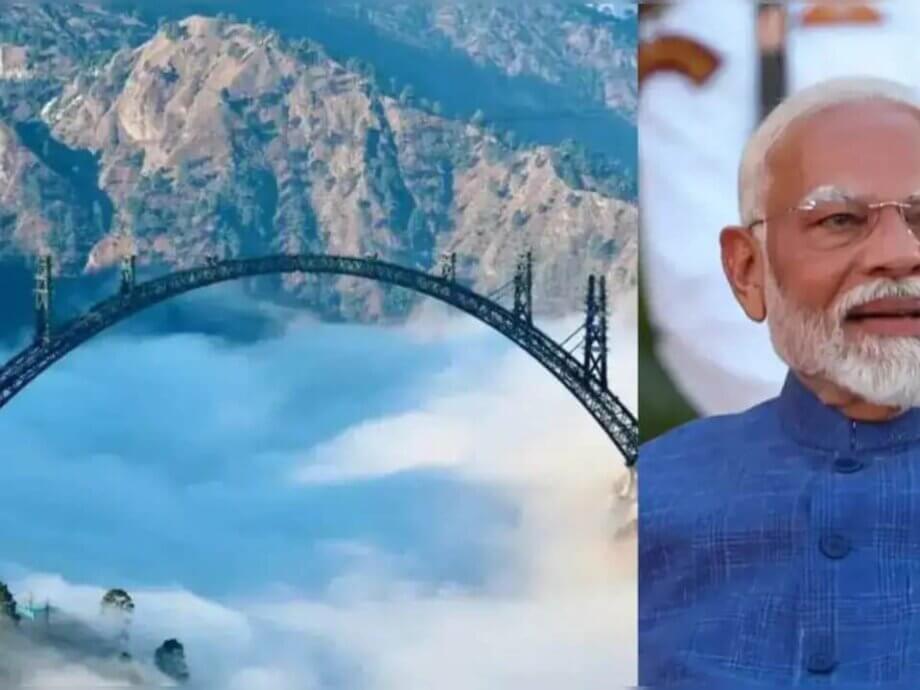India’s Chenab Bridge: A Record-Breaking Feat in the Heart of Kashmir
On June 6, 2025, Indian Prime Minister Narendra Modi inaugurated the world’s highest railway bridge, the Chenab Rail Bridge, in the mountainous region of Kashmir. Towering 359 meters (1,178 feet) above the Chenab River—making it 35 meters taller than the Eiffel Tower—this engineering marvel is more than just a bridge. It is a symbol of national ambition, a tool for regional integration, and a flashpoint in the geopolitics of South Asia. The bridge’s opening marks the completion of the Udhampur-Srinagar-Baramulla Rail Link (USBRL), connecting the Kashmir Valley to the rest of India by train for the first time in history.
- India’s Chenab Bridge: A Record-Breaking Feat in the Heart of Kashmir
- Engineering the Impossible: How the Chenab Bridge Was Built
- USBRL: Connecting Kashmir to the Indian Railways Network
- Economic, Social, and Strategic Impact
- Political and Geopolitical Dimensions: More Than Just a Bridge
- Environmental and Safety Concerns
- Voices from the Region: Hope, Pride, and Skepticism
- In Summary
Why the Chenab Bridge Matters
The Chenab Bridge is not just a record-setter; it is a transformative project for the region. For decades, Kashmir’s mountainous terrain and political volatility kept it isolated, with access limited to treacherous mountain roads or costly air travel. The new railway line, stretching 272 kilometers through 36 tunnels and over 943 bridges, now provides all-weather connectivity, promising to boost tourism, trade, and social integration.
Prime Minister Modi, addressing the nation at the inauguration, declared:
“The Tricolour flies high over the Chenab Rail Bridge! It’s a feeling of immense pride that this bridge seamlessly blends ambition with execution, reflecting India’s growing capability to build futuristic infrastructure in the most challenging terrains. The inauguration of mega infrastructure projects today marks a turning point in Jammu and Kashmir’s development journey.”
His words reflect the government’s vision of using infrastructure to bind the region more closely to the Indian mainland, both physically and emotionally.
Engineering the Impossible: How the Chenab Bridge Was Built
The Chenab Bridge is a single-arch steel structure stretching 1,315 meters (4,314 feet) across a deep gorge in the Reasi district of Jammu and Kashmir. Its main deck rises 359 meters above the riverbed, making it the highest rail bridge and the tallest arch bridge on the planet. The bridge was designed by WSP Finland and constructed under the supervision of the Konkan Railway Corporation, with input from thousands of engineers, geologists, and workers over more than two decades.
Building in the Himalayas posed unique challenges:
- Seismic Risks: The region is prone to earthquakes. The bridge is engineered to withstand quakes up to magnitude 8 and wind speeds up to 266 km/h (165 mph).
- Harsh Terrain: The Chenab gorge features fractured rock, high seismic activity, and unpredictable weather. Specialized cable cranes and mountain-side assembly were required to transport and position materials.
- Blast-Resistant Materials: Given security concerns in the conflict-prone region, the bridge uses blast-proof steel and self-compacting concrete.
- Longevity: The bridge is designed to last at least 120 years, with advanced construction software ensuring precision and safety.
Dr. G Madhavi Latha, a geotechnical consultant on the project, emphasized the collective effort behind the achievement:
“All glory of the planning, design and construction goes to Indian Railways and AFCONS. My contribution was in the specialized area of slope stabilization and foundation design on difficult terrain—a critical but narrowly defined responsibility in a project that required the coordinated effort of hundreds of engineers, workers, and planners over several years.”
Construction milestones included the commissioning of a cable crane in 2013, the incremental launch in 2017, the arch closure in April 2021, and the final ‘Golden Joint’ ceremony in August 2022. The bridge officially surpassed China’s Najiehe Railway Bridge to become the world’s tallest.
USBRL: Connecting Kashmir to the Indian Railways Network
The Chenab Bridge is the crown jewel of the USBRL project, a 272-kilometer railway line that begins in Udhampur (Jammu region), passes through Srinagar (Kashmir’s main city), and ends in Baramulla near the Line of Control with Pakistan. The project cost approximately ₹43,780 crore (about $5 billion) and includes:
- 36 tunnels totaling 119 kilometers, including India’s longest transport tunnel (T50, 12.77 km)
- 943 bridges, including the Chenab Bridge and the Anji Khad Bridge (India’s first cable-stayed rail bridge)
- Electrified tracks for energy-efficient and sustainable rail transport
- Specially adapted Vande Bharat Express trains, capable of operating in temperatures as low as -20°C
The USBRL project faced repeated delays due to the region’s difficult geology, harsh winters, and security concerns. The main arch of the Chenab Bridge was completed in April 2021, but the full line only became operational in 2025.
Vande Bharat Trains and All-Weather Connectivity
With the inauguration, two Vande Bharat Express trains now connect Katra (in Jammu) and Srinagar (in Kashmir), reducing travel time to about three hours. These trains are equipped with heated windshields, insulated toilets, and a dedicated snow clearance train, ensuring year-round operations even in the harshest Himalayan winters.
Economic, Social, and Strategic Impact
The completion of the USBRL and the Chenab Bridge is expected to have far-reaching effects on the region:
- Tourism: Kashmir, often called “Paradise on Earth,” is famous for its scenic beauty but has been hard to reach. The new railway is expected to boost spiritual and adventure tourism, making it easier for pilgrims and tourists to visit destinations like Vaishno Devi, Gulmarg, and Pahalgam.
- Trade and Agriculture: The railway will streamline the movement of goods such as apples, dry fruits, pashmina shawls, and handicrafts, reducing costs and improving access to markets across India.
- Job Creation: Construction and ongoing railway operations are expected to create thousands of jobs, both directly and indirectly.
- Military Mobility: The railway enhances the movement of troops and supplies in one of the world’s most militarized regions, a strategic advantage for India.
According to The Indian Express, the railway is poised to revolutionize the local economy by making the transport of daily essentials faster and cheaper, while also integrating the region more closely with the rest of the country.
Political and Geopolitical Dimensions: More Than Just a Bridge
The Chenab Bridge’s inauguration comes at a time of heightened tensions in Kashmir. Just weeks before the opening, a deadly attack in Pahalgam killed 26 tourists, triggering the worst military standoff between India and Pakistan since 1999. India blamed Pakistan for supporting militants, leading to a brief but intense exchange of missiles, drones, and artillery. A ceasefire was agreed on May 10, but the region remains volatile.
For Prime Minister Modi’s government, the bridge is a symbol of India’s resolve to integrate Kashmir—both physically and politically—into the national mainstream. Since 2019, when New Delhi revoked the region’s special constitutional status (Article 370), the government has invested billions in infrastructure, aiming to promote stability, reduce corruption, and boost the economy.
However, the project is not without controversy. Critics argue that the railway primarily serves Indian interests, facilitating the movement of troops and Hindu pilgrims, while displacing local farmers and altering the region’s demographic and economic landscape. Middle East Eye notes that the project echoes colonial strategies of using infrastructure to assert control, and that travel for Kashmiris remains restricted, with ongoing security checks and internet shutdowns.
“Despite its engineering marvel, the railway symbolizes India’s unnatural grip on the region, with critics arguing it is more about occupation than development.” — Middle East Eye
Supporters, however, see the bridge as a unifying force. As Armenpress puts it, the Chenab Bridge is “a symbol of unity, resilience, and India’s unyielding spirit to conquer the impossible.”
Environmental and Safety Concerns
The scale of construction in the fragile Himalayan ecosystem has raised alarms among environmentalists. Large infrastructure projects like the Chenab Bridge and the Char Dham Highway in Uttarakhand have been criticized for destabilizing slopes, increasing landslide risks, and accelerating the effects of climate change. Recent incidents—including the collapse of a tunnel in Uttarakhand and bridges in Mizoram and Bihar—have also raised questions about construction quality and safety standards.
Indian Railways and project engineers insist that the Chenab Bridge and the USBRL have been built to the highest safety standards, using advanced monitoring systems and materials designed to withstand the region’s extreme conditions. The bridge’s design life of 120 years and its ability to withstand earthquakes and high winds are testaments to this commitment.
Voices from the Region: Hope, Pride, and Skepticism
The inauguration of the Chenab Bridge has been met with a mix of pride, hope, and skepticism among Kashmiris and Indians alike. For many, the bridge is a source of national pride and a testament to human ingenuity. For others, it is a reminder of the region’s contested status and the ongoing struggle for autonomy and identity.
Local engineers and workers who contributed to the project see it as the fulfillment of a dream. T G Sitharam, Chairman of the All India Council for Technical Education (AICTE), described the bridge as “a 15-year journey of science, sweat, and soul.”
For ordinary Kashmiris, the railway promises easier travel, better access to goods and services, and new economic opportunities. Yet, concerns remain about displacement, environmental impact, and the broader political context.
In Summary
- The Chenab Rail Bridge, inaugurated on June 6, 2025, is the world’s highest railway bridge, standing 359 meters above the Chenab River in Kashmir.
- The bridge is the centerpiece of the USBRL project, a 272-kilometer railway line connecting Kashmir to the Indian mainland by train for the first time.
- Built over two decades, the bridge is an engineering marvel, designed to withstand earthquakes, high winds, and harsh Himalayan conditions.
- The railway promises to boost tourism, trade, and military mobility, while also raising concerns about environmental impact and political control.
- The project is both a symbol of national unity and a flashpoint in the ongoing conflict over Kashmir, reflecting the complex interplay of engineering, politics, and identity in the region.
- While celebrated as a triumph of Indian engineering and ambition, the bridge’s legacy will depend on how it shapes the lives and aspirations of the people of Kashmir.




